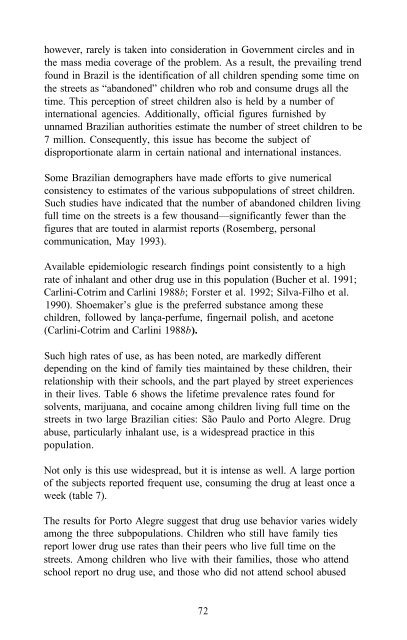Epidemiology of Inhalant Abuse - Archives - National Institute on ...
Epidemiology of Inhalant Abuse - Archives - National Institute on ...
Epidemiology of Inhalant Abuse - Archives - National Institute on ...
You also want an ePaper? Increase the reach of your titles
YUMPU automatically turns print PDFs into web optimized ePapers that Google loves.
however, rarely is taken into c<strong>on</strong>siderati<strong>on</strong> in Government circles and in<br />
the mass media coverage <str<strong>on</strong>g>of</str<strong>on</strong>g> the problem. As a result, the prevailing trend<br />
found in Brazil is the identificati<strong>on</strong> <str<strong>on</strong>g>of</str<strong>on</strong>g> all children spending some time <strong>on</strong><br />
the streets as “aband<strong>on</strong>ed” children who rob and c<strong>on</strong>sume drugs all the<br />
time. This percepti<strong>on</strong> <str<strong>on</strong>g>of</str<strong>on</strong>g> street children also is held by a number <str<strong>on</strong>g>of</str<strong>on</strong>g><br />
internati<strong>on</strong>al agencies. Additi<strong>on</strong>ally, <str<strong>on</strong>g>of</str<strong>on</strong>g>ficial figures furnished by<br />
unnamed Brazilian authorities estimate the number <str<strong>on</strong>g>of</str<strong>on</strong>g> street children to be<br />
7 milli<strong>on</strong>. C<strong>on</strong>sequently, this issue has become the subject <str<strong>on</strong>g>of</str<strong>on</strong>g><br />
disproporti<strong>on</strong>ate alarm in certain nati<strong>on</strong>al and internati<strong>on</strong>al instances.<br />
Some Brazilian demographers have made efforts to give numerical<br />
c<strong>on</strong>sistency to estimates <str<strong>on</strong>g>of</str<strong>on</strong>g> the various subpopulati<strong>on</strong>s <str<strong>on</strong>g>of</str<strong>on</strong>g> street children.<br />
Such studies have indicated that the number <str<strong>on</strong>g>of</str<strong>on</strong>g> aband<strong>on</strong>ed children living<br />
full time <strong>on</strong> the streets is a few thousand—significantly fewer than the<br />
figures that are touted in alarmist reports (Rosemberg, pers<strong>on</strong>al<br />
communicati<strong>on</strong>, May 1993).<br />
Available epidemiologic research findings point c<strong>on</strong>sistently to a high<br />
rate <str<strong>on</strong>g>of</str<strong>on</strong>g> inhalant and other drug use in this populati<strong>on</strong> (Bucher et al. 1991;<br />
Carlini-Cotrim and Carlini 1988b; Forster et al. 1992; Silva-Filho et al.<br />
1990). Shoemaker’s glue is the preferred substance am<strong>on</strong>g these<br />
children, followed by lança-perfume, fingernail polish, and acet<strong>on</strong>e<br />
(Carlini-Cotrim and Carlini 1988b).<br />
Such high rates <str<strong>on</strong>g>of</str<strong>on</strong>g> use, as has been noted, are markedly different<br />
depending <strong>on</strong> the kind <str<strong>on</strong>g>of</str<strong>on</strong>g> family ties maintained by these children, their<br />
relati<strong>on</strong>ship with their schools, and the part played by street experiences<br />
in their lives. Table 6 shows the lifetime prevalence rates found for<br />
solvents, marijuana, and cocaine am<strong>on</strong>g children living full time <strong>on</strong> the<br />
streets in two large Brazilian cities: São Paulo and Porto Alegre. Drug<br />
abuse, particularly inhalant use, is a widespread practice in this<br />
populati<strong>on</strong>.<br />
Not <strong>on</strong>ly is this use widespread, but it is intense as well. A large porti<strong>on</strong><br />
<str<strong>on</strong>g>of</str<strong>on</strong>g> the subjects reported frequent use, c<strong>on</strong>suming the drug at least <strong>on</strong>ce a<br />
week (table 7).<br />
The results for Porto Alegre suggest that drug use behavior varies widely<br />
am<strong>on</strong>g the three subpopulati<strong>on</strong>s. Children who still have family ties<br />
report lower drug use rates than their peers who live full time <strong>on</strong> the<br />
streets. Am<strong>on</strong>g children who live with their families, those who attend<br />
school report no drug use, and those who did not attend school abused<br />
72
















